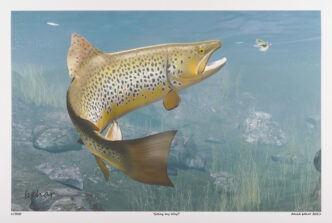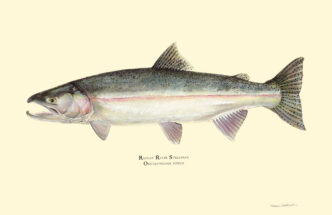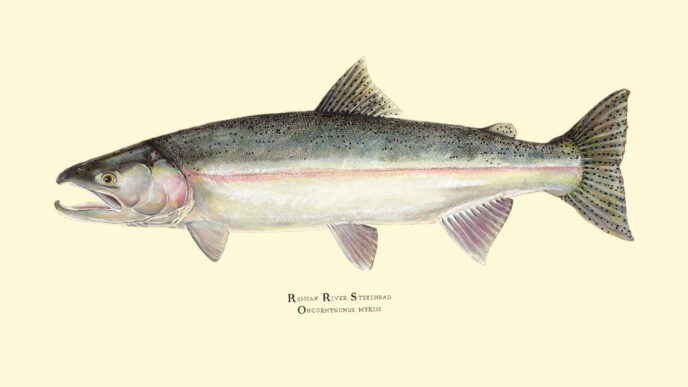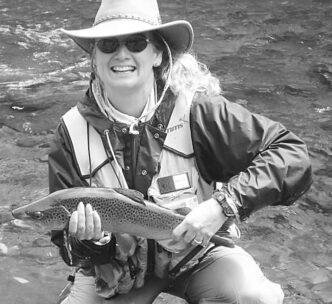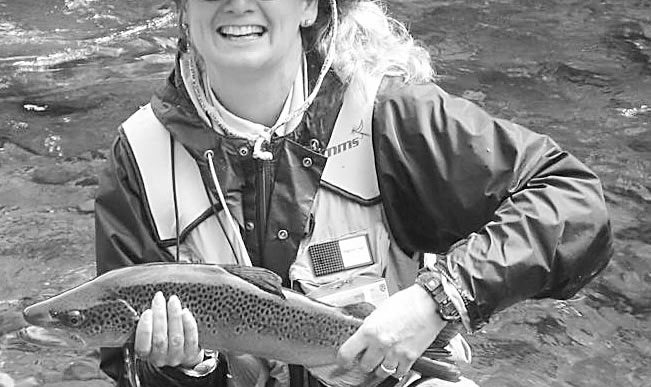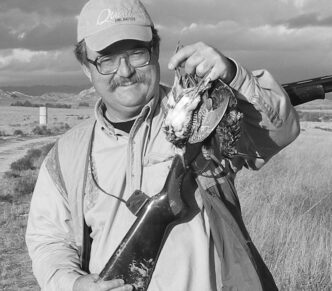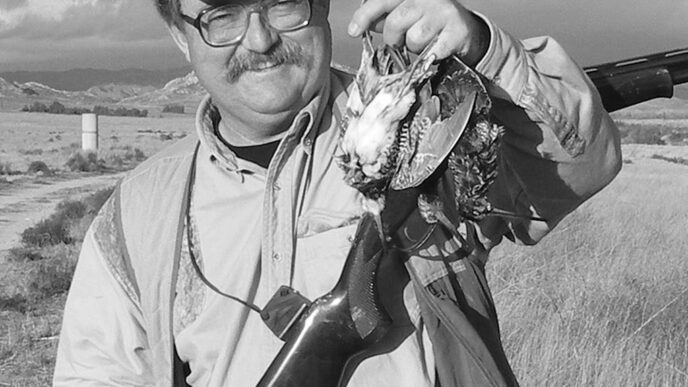Tom Chandler is the founder and, with Wally the Wonderdog, the presiding spirit of the Trout Underground blog, ground.com, “Fly Fishing’s Fun, Independent Site.” A writer, freelance marketing consultant, and refugee from Silicon Valley, he lives and fishes in Dunsmuir, in the heart of Northern California’s trout country. Because the Internet has increasingly become a principal resource for those seeking information, entertainment, and interpersonal connections related to fly fishing (and for some, it has become the principal resource for such things), we decided to go a little “meta” in this edition of “California Confluences” and focus on someone well qualified to discuss the changing mediascape that fly fishers now encounter.
Bud: First off, welcome to the Jurassic Park of fly-fishing media — print! One of the reasons we thought that interviewing you would be interesting is because you’ve been critical of the ways that old-fashioned hardcopy fly-fishing magazines have soldiered on in the digital era. In a thread begun in 2006, around the time that you started your blog, you and your commenters laid out the case against old-media platforms for serving an audience of fly fishers and made the case for Internet-based media such as blogs, bulletin boards, and on-demand publishing. You actually said a few nice things about California Fly Fisher, but here’s a quick summary of the criticisms made by you and your commentators.
The dead-tree fly-fishing media fail to focus “on the fly-fishing experience.” What they publish is “PR in disguise” for writers, guides, equipment manufacturers, and destinations, and “much of it is vacuous how-to” by those who claim to be experts, but aren’t all that expert, when what readers really want is not how-tos, but “a good read.” By contrast, blogs and their ilk represent “the democratization of fishing information,” develop a sense of “community” in which information is shared, and increasingly are attracting not just readers, but advertising dollars, dooming the hardcopy dinosaurs.
However, 2006 was several eons ago, as time flies in the digital age. In a brief update to the thread, posted in March 2011, you note that things indeed have changed somewhat. How do you see the relationship between traditional fly-fishing media and online fly-fishing publications as we lurch into 2012?
Tom: In 2006, a lot of writers were waking up to the idea that we had viable online alternatives to what we viewed as a tier of fossilized, formulaic flyfishing magazines. We didn’t want to write what they were buying, and with the rise of cheap, easy digital publishing, we didn’t have to.
The post you cited was as a response to a writer who said that fly-fishing magazines were paying less than they did just a few years prior (true) and that the amateurs on the Internet were to blame (false).
In truth, I don’t know how to describe the “relationship” between the print and online media, because there doesn’t seem to be one.
I maintain that fishing’s print magazines will eventually go digital; whether the publications survive the transition or are replaced by something else is entirely up to them. They would be smart to note what breeds success online (I’d suggest it’s a little different than in print), and if I were them, I’d worry about some of the new ezines and blogs, which are pretty damned good.
Print magazines enjoy a lot of advantages; they’ve already got relationships with writers, photographers, and (most importantly) advertisers, but momentum is a hard thing, and to many of them, the online folks are just the noisy neighbors.
I’m just one writer who blogs part time, and I’ve got the monthly readership of a small national magazine. What happens when a few of us get together with an ad sales guy and decide to get serious?
Bud: You’ve said that “fly-fishing magazines are marketers of information,” and you’re a marketing guy. As I understand it, what you offer as both a marketer and a blogger is what you call “engagement marketing” — not just bludgeoning your way into the consciousness of a potential customer or reader, but establishing an ongoing relationship with them by using engaging content to build a community and “demonstrating a commonality of passion.” How can fly-fishing magazines improve in that regard, and what do you see as the impediments to doing so? And yeah, like someone talking to an M.D. at a cocktail party, I’m asking for free professional advice here.
Tom: Engagement marketing in the online age is basically an improved version of customer retention. The idea is this: the more engaged subscribers are with your magazine, the easier it is to keep your subscribers.
Fly-fishing magazines have been slow to embrace this. They’ve been able to get away with it because of fly fishing’s demographic, which is still heavily weighted toward 45-plus-year-old men who read and buy in traditional ways.
I think the grace period is going to expire in a few years — as it just has for traditional book publishers — and I would suggest the bigger magazines still don’t really get it. Their websites now support blogs, but most of their online content is pretty boring, and I can’t help but notice at least one mag has recruited fly fishermen from within the industry instead of looking for good writers who can tell a story.
That won’t fly.
We’re finally seeing digital distribution from some (Fly Tyer’s iPad app, Fly Rod & Reel’s special supplements), and I’m very interested to see what they find when they go online. They’re going to have do better than the existing ezines and blogs.
Bud: All media have inherent constraints, and in most media, characteristic genres have developed. The newsprint on which this magazine is printed, for example, doesn’t reproduce photographs as well as glossy paper does, while posting photos online is pretty easy. And the power of generic expectations is strong — readers simply expect certain things from angling magazines. I get it that you see a predominance of pluses with regard to online media. What do you see as the negatives — the constraints inherent in the medium itself?
Tom: Online media does some things pretty poorly, though in most respects, it’s made publishing words, photos, videos and audio almost absurdly easy. In fact — the joys of holding a book or magazine in your hands aside — digital technology often delivers a richer experience, though as Nicholas Carr has noted, it sometimes does so at the expense of deeper, more reflective thought.
Online media does have a sizable problem: people believe that everything coming through their Web browser should be free. That’s why so many traditional media companies are embracing “apps,” where readers don’t expect a free ride, even if the content is the same.
Simply put, publishing digital content is easy. Getting paid for it is hard.
Bud: One of your complaints about mainstream fly-fishing magazines is that they tend to publish what amounts to PR pieces. One of the ongoing worries that I have with this column is that by interviewing people prominent in the California fly-fishing world, many of whom are in the fly-fishing business in some way, I may just end up promoting their business. How would you suggest that I avoid promoting Troutunderground.com?
Tom: The problem isn’t promotion, it’s a lack of transparency, fortified by a healthy dollop of conflict of interest. And it’s not unique to mainstream fly-fishing magazines; I’m seeing the same things online.
A simple example is a destination article written by an employee of the lodge in question (or a guide, or a travel-service employee). When a writer has a financial interest in making that destination irresistible, you’re unlikely to hear about the cockroach infestation or the surly guides.
Freelance writers who receive free lodging/guiding/airfare to a pricey destination are in a similar boat and should disclose the freebies, so readers can make their own judgments.
Otherwise, it’s not editorial content, it’s advertising.
Product reviews occupy a touchy middle ground; the value of the product being tested isn’t typically all that high, but negative reviews are still extremely rare. Are all these products really that flawless, or are magazines and writers protecting their revenue/freebie stream?
A couple of us have posted negative reviews of products and lived to tell about it, but the reaction hasn’t always been pretty. Would I get more products to review if I were less critical? The answer is probably yes. Thankfully, I’ve never been that interested in writing product reviews; my fishing time is limited, and testing things means some of that precious time is spent using products I don’t necessarily like.
So if you’re concerned about promoting the Trout Underground — which is not really a business — I’d suggest you worry about it after you send me on all-expenses paid trip to the Bahamas.
Bud: Could you talk a bit about the nuts and bolts of running a blog like Troutunderground.com? What, broadly speaking, are the economics and investment of personal time involved? What’s it take to sustain an “engaged” community? How many unique visitors do you get, annually, for example?
Tom: Starting and running a blog is extremely easy, provided you’re happy writing for an audience of two (your dog and your mother). Technology has made publishing digital content almost childishly easy, and what’s left is the part where you arrange words and photographs in pleasing ways.
Which sounds a lot easier than it is.
A key difference between online and print is this: unless you’re interested in losing a lot of money, the very act of printing and mailing a magazine means you’ve got expenses, which means you’d better round up some advertisers.
By contrast, you can sign up for your free WordPress.com blog, babble away, and incur zero risk to your 401(k).
It’s likely that nobody’s listening, but over time, that can change. And I will say this: writing a blog offers an immediacy that translates — at least in my eyes — to an intimacy that is hard to find elsewhere.
Some weeks, I invest a couple hours in the Trout Underground. Other weeks, I’ll muck around for as much as 10 or 15 hours. (It also serves as a live test bed for technology we’re testing for client sites.)
Like most career writers, I’m compulsive about writing (though unlike many of them, I’m not fast), and I miss it when I don’t post for a couple days.
I’ve been told the attraction of the Trout Underground is that I’m not promoting an agenda; I’m just fishing and writing about it and inviting folks to come along. Along the way, I’m offering up a few tips and a handful of gear and book reviews, conservation news, industry rants, etcetera.
I would like to think my readers keep returning to experience my blinding insight, but it’s just as likely they want to know what’s happening to Wally the Wonderdog.
I guess I’d say the writing’s never easy, but the formula is pretty simple.
As for my numbers, I had to check. Google says the Underground will see more than 210,000 unique visitors this year. Since switching to WordPress blog software in 2006 (the site was founded in 2005), I’ve published 828,000 words (not including comments), which means I’m probably closing in on a million. Not bad for a guy with a gimpy dog.
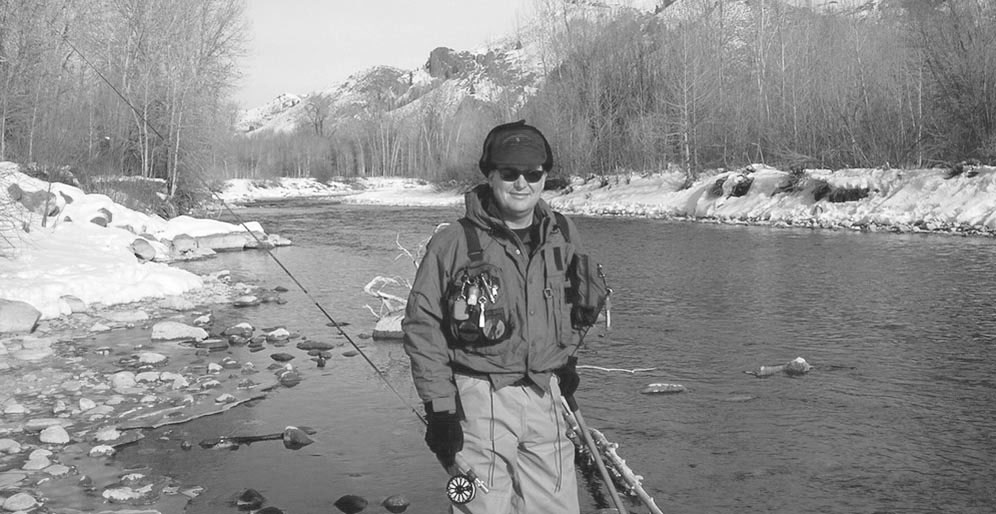
Bud: Enough with the meta stuff. “The Trout Underground Manifesto” declares that “fly fishing is supposed to be fun,” and you’ve inveighed against the pursuit of what I’d call “serious fun,” in the sense that if someone is going to take time off from their busy, high-pressure life, they expect to be compensated by some busy, high pressure enjoyment. I gather that digital wonk though you may be, when it comes to angling, you’re into cane and glass rods and the slow approach to fly fishing that slow rods exemplify. What does angling “fun” mean to you?
Tom: I’ve been known to howl at the moon a little when it comes to fly fishing’s body counters, but I also recognize that everybody’s in this for their own reasons.
I fish mostly low-modulus rods because they feel like I think fly rods are supposed to feel. Of course, whenever you show up with dry flies and a bamboo rod, some folks want to translate that into some kind of purist head trip, but that’s them, not me.
If I got to fish only a half-dozen times a year I’d probably take a less laid-back approach (which often involves bank sitting), but I live minutes away from some seriously good fishing, so I’ve got the luxury of going about it exactly the way I’d like.
The last couple years, I’ve found small streams hugely compelling, sometimes driving right by bigger fish on bigger rivers to fish trickles. I can’t explain it, but then my readers are all fly fishers, so they get it, or if they don’t, they understand it’s just another symptom of the disease we all share.
Bud: And how did you get to be a digital wonk in the marketing trade? When asked “What do you want to be when you grow up?” most people don’t say “I want to be an advertising copywriter.” What did you major in as an undergraduate, for example? As all this was happening, did angling get shunted aside, or was it always there as a mental-health resource?
Tom: I was a photojournalism major at San Jose State, but was recruited as a copywriter by a national ad agency right out of college. I’m fortunate: working as a freelance copywriter allows me to live in the middle of nowhere — where I can occasionally ditch work for the March Brown hatch.
I’m a good copywriter and an effective marketing consultant, and while I have job-related stresses, I’m probably doing better than if I’d chased dollars and stayed in Silicon Valley.
I’m happy about my choices. Even with a kid and a mortgage, I get to fish more than most and work at something I like, which puts me ahead of a lot of people.
Bud: Although like many longtime fly fishers, you get impatient with “how-tos,” as one commenter on your site remarked, in one way or another, “none of us are past the how-to stage.” How, when, and where did you start out fly fishing, and who was there to supply the how-to for you?
Tom: I’m self-taught, which probably feeds my impatience with how-to articles. As a culture, I think we’re losing the ability to differentiate between reading about something on the Internet and actually doing it, with people sometimes disastrously conflating the two.
As for my origins, there was no outdoor sports tradition in my family, yet for some reason I always wanted to fish. I missed the really gory pulp outdoor-magazine era, but in the early 1970s, I read every fishing book and magazine at the library.
When I was old enough to ride my bike the 10 miles to a nearby lake, I became a fisherman. In the late 1970s, I built a fly rod on a 7.5-foot Fenwick glass blank. I fly fished some during my high-school and college years, but mostly fished for warmwater fish, there being a distinct lack of trout in suburban Southern California. I even entered some bass tournaments during the 1990s. I enjoyed the fishing, but not what the competition did to fishermen.
More than 20 years later (April 23, 1999 — the day before the trout opener), I moved to my funky two-bedroom house in Dunsmuir.
I had float tubes hanging in the living room, a fly-tying desk in the corner, and I was drying my bamboo fly rods in the front closet. I had no television and populated the place with plastic lawn furniture. A friend remarked that it looked like the kind of place where a serial killer would live.
Bud: I agree that criticism of the dissemination of Web-based angling information because it comes from “amateurs” is silly, but as the proprietor of a popular blog, you’ve by definition laid claim to being someone with something to say about the sport. So what do you say about its present state and future prospects — not just on the publishing end, but in general? The sort of attitude exemplified by The Drake magazine or by Mikey Weir in his videos, to name two sources, seems to suggest that there’s a vitality out there that promises to animate the sport, contrary to worries about its demise.
Tom: I’ve seen a lot of hand-wringing by industry folks about the growth of the industry and the “health” of the sport, but they’re making the fundamental error of conflating the two.
A lot of fly-fishing companies grew fat during the boom years, but with growth flattening out and the Internet dropping a bomb on publishing and traditional dealer-based product distribution, it’s not that surprising to see one-third of the independent fly shops closing over the last decade.
The downside to a lack of growth is fewer advocates for conservation — and that’s a reasonable concern — but let’s also consider the Internet’s facility as an organizational medium. We’ve got a channel for advocacy that far outstrips anything we had before.
When my county’s board of supervisors wanted to (illegally) declare all the rivers in Siskiyou County non-navigable, which would have a significant impact on public access to the upper Sac and McCloud, we managed to mount a campaign that saw the supervisors on the receiving end of 1000-plus e-mails.
California Fly Fisher managed to run a short piece, but on the whole, it was online media (mostly blogs and message boards) that carried the day. Most print media were rendered helpless by the short deadlines and need for immediate action.
In truth, I think we’re better off than we were in the 1980s and 1990s.
Bud: Here we are at the infamous Silly Tree Question. If you were a tree, what kind of a tree would you be?
Tom: As a small-stream fly fishermen, I can tell you I wouldn’t be a willow tree. I hate the damned things.
I’d probably go with a cedar. Nice leaves, sheds snow, smells good, not too dense. That’d be me.






